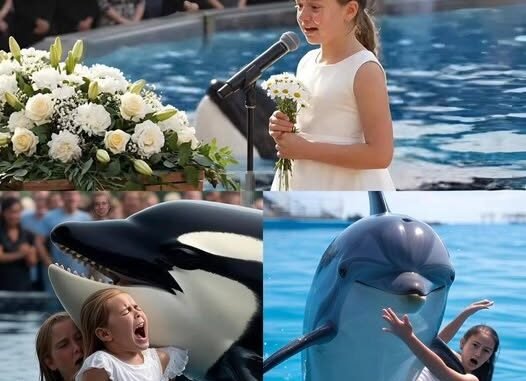
Tragedy at SeaWorld: A Whale’s Grief and a Daughter’s Fate
The air at SeaWorld San Diego was heavy with anticipation, a mournful quiet that belied the usual joyful noise of the park. Thousands had gathered not for a performance, but for a solemn tribute to a fallen legend: renowned whale trainer, Alex “Ace” Morgan. For over thirty years, Ace had been a cornerstone of the park, his bond with the orcas legendary, his compassion for the massive creatures a beacon for all. But a sudden, freak accident during a routine training session had taken his life, leaving a void in the hearts of his colleagues, friends, and, most poignantly, the very whales he had dedicated his life to.
The main event of the tribute was to be a special performance by Orion, a magnificent bull orca who had been Ace’s partner for over two decades. The plan was simple, yet emotionally charged: Ace’s daughter, 22-year-old Lily, a trainer herself who had followed in her father’s footsteps, would be in the water with Orion. The whale would perform a series of gentle, slow movements, a choreographed dance of remembrance, as Lily delivered a tearful eulogy from a platform in the middle of the pool.
As the eulogy began, the crowd held its breath. Lily’s voice, though trembling, was clear and heartfelt. She spoke of her father’s love for the whales, his unwavering belief in their intelligence and capacity for emotion. Orion, a massive, sleek black and white form, seemed to listen, circling slowly beneath her, his powerful body a silhouette of sorrow. Tears streamed down Lily’s face as she recounted a memory of her father and Orion playing together in the pool, a moment of pure joy that now felt like a lifetime ago.
And then, it happened. A sudden shift in Orion’s behavior. The grief, a deep, animal sorrow that no one could truly comprehend, seemed to overwhelm the massive creature. He let out a piercing, mournful cry that echoed through the stadium, a sound that was less a whale’s call and more a primal scream of anguish. The gentle circling ceased. Instead, a powerful, erratic motion. Orion breached the water’s surface, not in a graceful arc, but in a sudden, violent eruption of water and muscle. He shot upwards, his immense body propelled by a force born of grief and confusion.
Lily, standing on the platform, had no time to react. The wave from Orion’s breach hit her with the force of a tsunami. She was thrown from the platform, her body tossed like a ragdoll into the turbulent water. The crowd, a collective gasp of horror, watched in silent terror. But the tragedy was not over. In his grief-stricken state, Orion seemed to lose all awareness of his surroundings. He dove back into the pool, his powerful tail and body a maelstrom of destruction. A massive dorsal fin, a symbol of his strength and majesty, sliced through the surface of the water as he thrashed.
When the dust settled, the water was calm once more. A terrifying, unnatural stillness had replaced the chaos. SeaWorld staff, a blur of motion and panicked faces, dove into the water. The scene was one of abject horror. Lily’s body, lifeless and broken, was found floating near the edge of the pool. The dream of a tribute, of a final moment of peace and remembrance, had turned into a nightmare.
The aftermath was a whirlwind of grief, blame, and a renewed debate about the ethics of keeping such magnificent, intelligent creatures in captivity. Animal rights activists, who had long protested SeaWorld’s practices, pointed to the incident as a tragic but inevitable consequence of a system that denies these animals their freedom. They argued that Orion’s behavior, while seemingly a violent act, was in fact a manifestation of deep psychological trauma, a grieving animal lashing out in a state of confusion and despair. The tragedy, they claimed, was not an accident, but a foreseeable outcome.
SeaWorld, reeling from the tragedy, defended its practices, but the public relations nightmare was undeniable. The image of the grieving whale and the broken body of the trainer’s daughter became a haunting symbol of the inherent dangers and moral ambiguities of their business. The very foundation of their existence, the idea that humans could coexist and even bond with these wild creatures in a controlled environment, had been shattered in a single, horrifying moment. The tribute to a beloved trainer had become a public execution, a brutal reminder that some things, no matter how much we wish to control them, are forever wild and untamable.
Leave a Reply